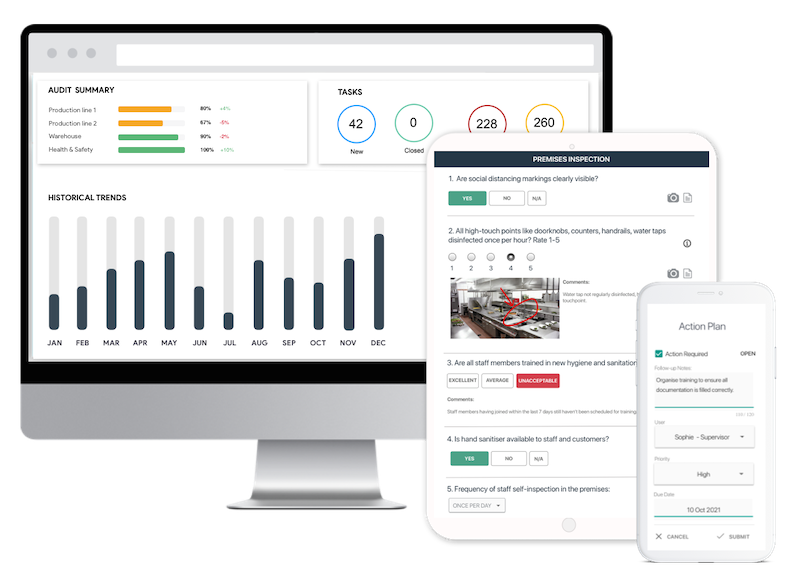Workplace Inspection Checklist Templates
Template Library > Safety Inspections > Workplace Inspections
Standardize Audits and Inspections With Workplace Inspection Templates
Workplace inspections are critical for spotting hazards, maintaining safety standards, and staying compliant with regulations. A structured workplace inspection checklist helps standardize reviews, reduce risk, and promote a proactive safety culture.
With a comprehensive workplace inspection template, you can:
- Spot and address safety issues before incidents occur.
- Standardize inspection routines across departments and shifts.
- Maintain compliance with occupational health and safety regulations.
With the GoAudits Safety Inspection App, you can:
- Eliminate paperwork: conduct efficient digital audits, add photos from mobile device
- Customize this template or easily create your own
- Save time with instant reports & assign corrective actions
Information
Incidents
Strains And Sprains
Chemical Hazards
Records And Statistics
First Aid
Information
Incidents
Strains And Sprains
Chemical Hazards
Records And Statistics
First Aid
Save Time with Digital Inspections
- Easily capture & attach photos, directly on your mobile device.
- Instantly generate and share detailed reports after the inspection.
- Track corrective actions, view historical trends, improve standards.
What Is a Workplace Inspection Checklist?
A workplace inspection checklist is a systematic tool used to identify potential hazards, safety issues, and areas of non-compliance in a work environment. It can be used by safety officers, facility managers, or supervisors to conduct regular inspections across different zones, e.g., workstations, storage areas, emergency exits, electrical setups, and equipment.
Using a workplace inspection checklist ensures that nothing is missed, that corrective actions are tracked, and compliance standards are met:
- Identify and correct safety risks before they lead to accidents.
- Ensure compliance with workplace safety standards and regulations.
- Maintain clear records for audits, training, or internal reporting, fostering a proactive safety culture
What Should a Workplace Inspection Form Include?
A workplace inspection form should cover core areas of safety. While specifics vary by industry, common components of workplace safety inspection checklists include:
- Housekeeping & Cleanliness – Tidy workspace, organized storage, clear walkways, clutter-free spaces
- Emergency Equipment & Procedures – Fire extinguishers, alarms, first-aid kits, emergency signage and drills
- Electrical & Equipment Safety – Proper wiring, guarded machines, regular maintenance
- Personal Protective Equipment Checks – Availability of PPE, correct usage, condition of gear
- Hazardous Materials – Safe storage, proper labeling, spill containment
- Signage & Communication – Warning signs, safety instructions, visible contact info
- Employee Training & Behavior – Proper procedures followed, refresher training completed
- Compliance Checks – Alignment with OSHA, WHS, or local authority requirements especially when it comes to audit documentation, safety meeting records, and records of incident reports or near-misses.
Customizing Workplace Inspection Checklist Templates Based on Worksite Type and Risk Level
Not all workplaces face the same hazards: your templates should reflect the specific conditions of your worksite:
- Offices – Ergonomics, fire safety, trip hazards
- Construction sites – Fall protection, machinery, scaffolding checks
- Manufacturing plants – lockout/tagout procedures, ventilation, chemical storage and handling
- Warehouses – Racking safety, forklift operations, emergency exits
Risk level also plays a big role. Higher-risk environments, like those involving chemicals, confined spaces, or moving parts, need more detailed, frequent inspections. Lower-risk sites may get by with shorter checklists reviewed on a less regular basis.
When customizing your workplace safety inspection checklists:
- Start with the basics: Include general items like fire exits, lighting, first aid, and emergency signage.
- Layer in site-specific risks: Based on the nature of work, environment, and equipment used.
- Adjust the frequency: Daily, weekly, or monthly, depending on risk severity.
- Use clear language: So that every team member can understand and apply it correctly.
- Review and update regularly: As site conditions, equipment, or regulations change.
Common Hazards Found During Routine Workplace Inspections
Routine workplace inspections are designed to catch issues before they lead to injuries, equipment damage, or compliance problems. These checks help spot recurring hazards that might otherwise go unnoticed during day-to-day operations. Here are some of the most common risks identified during inspections:
Blocked Emergency Exits
It’s not uncommon to find fire exits partially blocked by storage boxes, carts, or other equipment. Even a temporary obstruction can be a serious safety issue in an emergency.
Slips, Trips, and Falls
Spilled liquids, loose cables, uneven flooring, or poor lighting; these small issues often cause some of the most frequent workplace injuries. Inspections help ensure high-traffic areas are kept safe and clear.
Improperly Stored Materials
Stacked items that are unstable or stored too high can pose a risk of falling. Inspections catch unsafe shelving practices or overloaded racks before they lead to accidents.
Worn or Damaged Equipment
Tools and machinery that aren’t regularly checked can develop faults over time. Inspections help spot frayed cords, missing guards, or malfunctioning parts that need repair or replacement.
Fire Hazards
This includes overloaded power outlets, improper storage of flammable materials, or blocked access to fire extinguishers. Routine inspections ensure fire safety standards are being followed.
Lack of Signage or PPE
Missing warning signs or insufficient personal protective equipment (PPE) can leave employees exposed to avoidable risks. Inspectors often flag these gaps so they can be corrected quickly.
Poor Housekeeping
Cluttered workspaces, overflowing bins, or disorganized tools not only affect productivity but also contribute to safety risks. Inspections help maintain cleanliness and order.
Who Conducts Workplace Inspections and How Often?
Depending on the industry and the type of worksite, inspection responsibilities may vary. Here’s a breakdown of the common roles involved and how frequently inspections typically take place.
Roles Involved in Workplace Inspections
Safety Officers
Usually part of the health and safety team, safety officers lead formal inspections. They’re trained to identify hazards, ensure compliance with safety standards, and document risks that might go unnoticed by others.
Supervisors and Line Managers
Supervisors are often responsible for informal, day-to-day checks within their departments. Because they’re closely familiar with daily operations, they can quickly spot unsafe behavior or faulty equipment.
Internal Audit or EHS Teams
In larger organizations, Environment, Health, and Safety (EHS) teams or internal auditors conduct structured inspections based on corporate or regulatory standards. These are often more comprehensive and data-driven.
Joint Health and Safety Committees (JHSC)
Where applicable, JHSC members, made up of both workers and management, participate in scheduled inspections to ensure a balanced perspective on safety issues.
Frequency of Inspections
- Daily/shift-based checks – conducted by supervisors or designated employees, with focus on obvious, immediate hazards, like blocked exits, wet floors, or equipment malfunctions
- Weekly/monthly – Formal safety reviews by safety officers or committee members, more thorough inspections that look at patterns or recurring issues
- Quarterly/annual – Comprehensive audits or third-party reviews that focus on long-term compliance, policy effectiveness, and system-level risks.
- Post-incident – Special investigations after accidents or near-misses or major equipment failures. These are investigative in nature and help in identifying root causes and corrective actions.
How Workplace Safety Audit Checklists Support Safety and Internal Compliance Standards
A well-structured checklist is more than just a list of tasks; it’s a tool for maintaining accountability, consistency, and compliance. Here’s how safety audit checklists support both everyday safety and broader internal health and safety standards.
- Reinforce Safe Work Practices – Ensure teams consistently follow safety procedures like PPE use, hazard control, and emergency readiness.
- Improve Internal Accountability – Assign tasks and sign-offs to create clear responsibility and reduce oversights.
- Standardize Inspections Across Sites – Apply the same safety protocols company-wide for consistency and easier benchmarking.
- Support Policy and Regulatory Compliance – Align checklists with internal policies and external regulations (e.g., OSHA, ISO).
- Provide Documentation for Continuous Improvement – Track recurring issues and use insights to update training and policies.
In short, health and safety checklists support more than just compliance; they help build a safety system that’s proactive, consistent, and easy to monitor across the board.
Simplify Audits With Digital Workplace Inspection Reports
Conducting inspections is only half the job; reporting them properly is just as important. Workplace inspection reports provide proof of compliance, highlight risks, and create a record for audits or follow-ups. Without clear reporting, inspections lose much of their value.
The Problem With Manual Reporting
Traditionally, inspection notes are written on paper or entered into spreadsheets. This leads to:
- Time wasted on formatting reports manually
- Missing details like photos or timestamps
- Difficulty in tracking corrective actions
- Inconsistent reporting across teams and sites
For busy safety managers, this slows down decision-making and leaves gaps in compliance documentation.
Turn Checklists Into Professional Reports in Seconds
With the GoAudits safety inspection app, every completed checklist can be converted into a professional, branded workplace inspection report instantly. Reports include:
- Instant branded inspection reports
- Attach photos & notes directly
- Automatic timestamps & signatures
- Shareable with managers, auditors, or regulators
By automating inspection reports, you save hours of admin work, reduce errors, and ensure your facility is always audit-ready.
👉 Need a workplace inspection report sample, template, or example? GoAudits offers a full library of health & safety inspection templates, which let you generate reports instantly after every inspection. Start your free trial now.
Standardize Safety Audits With Ready-to-Use Workplace Inspection Templates
A structured workplace inspection checklist makes it easier to carry out safety audits consistently across teams, locations, and facility types.
Customize Inspection Templates Based on Your Site
Using a ready-made workplace inspection checklist, you can standardize daily, weekly, or monthly safety checks. Templates can be tailored to cover key areas like:
- Walkways, stairs, and flooring conditions
- Electrical panels, equipment, and power tools
- Fire extinguishers, alarms, and emergency exits
- Lighting, ventilation, and noise levels
- First-aid stations and PPE availability
- Material storage and hazardous substances
Make Inspections Easier and More Effective with an Inspection App
By using a workplace inspection app, inspectors can move systematically through each area, flag potential hazards on the spot, and ensure nothing is overlooked.
Other Popular Workplace Checklists:
Digitize your Safety Inspections
- Easily perform audits anywhere on the site using a mobile device, even offline
- Attach photos to document issues or prove compliance
- Assign tasks, set deadlines and track progress - all within a single app
- Analyze data from audits to identify trends, pinpoint recurring issues, and assess compliance levels.





